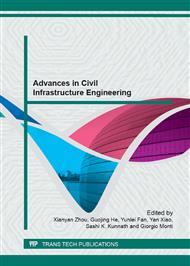[1]
Pauschke J, Anderson TL, Goldstein SN et al, Construction status of the George E. Brown, Jr. network for earthquake engineering simulation, Proceedings of the Seventh U.S. National Conference on Earthquake Engineering, Boston, 2002.
DOI: 10.1061/40558(2001)192
Google Scholar
[2]
Spencer BF et al, NEESGRID: a distribute collaboratory for advanced earthquake engineering experiment and Simulation, 13th World Conference on Earthquake Engineering, Vancouver, 2004, 1674.
Google Scholar
[3]
Kim JK, KOCED collaboratory program, Proceedings of the 2004 ANCER Annual Meeting, Hawaii, 2004.
Google Scholar
[4]
Ohtani K, Ogawa N, Katayama T, 3-D Full-Scale Earthquake Testing Facility and Earthquake Engineering Network, Proceedings of the Third World Conference on Structural Control. Como, Italy, 2002, pp.1019-1024
Google Scholar
[5]
Pan P, Tada M and Nakashima M, Online hybrid test by internet linkage of distributed test-analysis domains, Earthquake Engineering and Structural Dynamics. 34(2005): 1407-1425.
DOI: 10.1002/eqe.494
Google Scholar
[6]
Pan P, Tomofuji H and Wang T, Development of peer-to-peer (P2P) internet online hybrid test system, Earthquake Engineering and Structural Dynamics. 35(2006): 867-890.
DOI: 10.1002/eqe.561
Google Scholar
[7]
Yang YS, Wang SJ, Wang kJ, ISEE: Internet-based Simulations for earthquake engineering, Part I: the database approach, Proceedings of 13th world conference on Earthquake Engineering, Vancouver, 2004, p.1910.
Google Scholar
[8]
Wang kJ, Tsai KC, Wang SJ, et al. ISEE: Internet-based Simulation for Earthquake Engineering - Part II: The application protocol, Earthquake Engineering and Structural Dynamics. 36(2007): 1561-1579
DOI: 10.1002/eqe.729
Google Scholar
[9]
Xiao Y, Hu Q, Guo YR, Development of a network platform for remote hybrid dynamic Testing, Proceedings of 13th world conference on earthquake engineering, Vancouver, 2004, p.3048
Google Scholar
[10]
Xiao Y, Hu Q, Guo YR, et al. Networked platform for remote structural testing and shared use of laboratories. Progress in natural science, 2005; 15(12):1135-1142
DOI: 10.1080/10020070512331343196
Google Scholar
[11]
Xiao Y, Hu Q, Guo YR, et al. A network platform for remote pseudo-dynamic testing. Journal of Building Structure, 2005; 26(3):122-129 (in chinese)
Google Scholar


